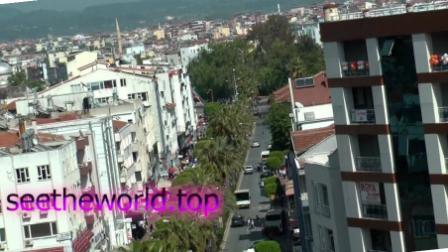
Manavgat is a very famous place among tourists who go to Antalya for a beach vacation in Turkey . After sea treatments and sunbathing, many people go to Manavgat to see various sights, which are plentiful here. Despite the small size of the city, it harmoniously combines objects of cultural heritage and modern architecture.
Vacation season in Manavgat
You can travel to this city at any time. It all depends on individual preferences and the purpose of the trip. For those who want to enjoy swimming in the sea, it is better to choose the period from the end of May to the end of October. The water temperature will please you with its positive indicators (+ 23-29), and the air already warms up to +27 degrees in May.
In November, the weather changes and starts to get colder. This is manifested, first of all, in a decrease in air temperature to + 18-15 degrees. The water in the sea also gradually cools down, and it is no longer possible to swim.
Winter in Manavgat is mild and warm, compared to most Ukrainian regions. So, in December, the air temperature ranges from +10 to +13 degrees. January is characterized by a drop in temperature to +9 degrees.
Winter and spring have the maximum number of bad days. However, this is not a reason to postpone the trip: stormy winds and long rains do not happen often.
TOP-10 interesting places in Manavgat
Manavgata Great Mosque
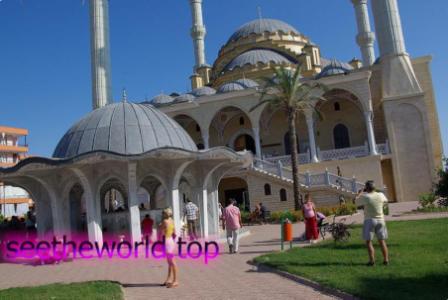
Turkey is famous for its mosques, the largest of which is located in Manavgat. This attraction has existed since 2004 and has already managed to gain popularity among local residents and pilgrims. It is worth noting the fact that everyone, regardless of religion, is allowed to enter the shrine, which is a rare phenomenon among Muslims.
The unusualness of the structure is that it includes 4 minarets, the height of each of which reaches 60 meters. The domes of the minarets are decorated with exquisite paintings in the Arabic style and beautiful stained-glass openings.
In front of the entrance to the mosque there is a fountain, where visitors must go through the rite of ablution. After the ritual, you can go inside the main minaret and collect water, which is considered healing.
Manavgata fountain
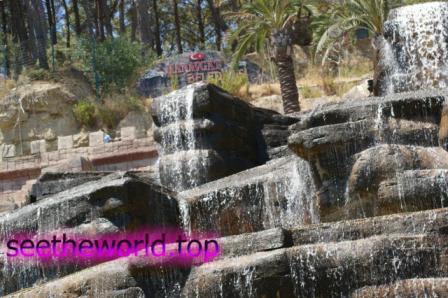
In the city, there is a significant amount of evidence that representatives of various civilizations and eras lived on its territory. Tourists can find one of them not far from the Arc de Triomphe. The date of creation of the fountain is 74 AD. Historians were able to determine the exact time of creation of the masterpiece thanks to the inscription, which tells that the fountain was installed during the reign of the Roman emperor Vespasian.
From the outside, the fountain resembles a pile of stones stacked on top of each other in a certain sequence. Streams of water flow from holes made in stone blocks. In the upper part of the fountain, there are statues depicting Roman rulers and high-ranking officials. The fountain is still functioning, captivating not only the residents of the city, but also its guests.
Triumphal Arch in Manavgat

The sights located in the town of Side are considered the cultural heritage of Manavgat, as these settlements are separated by only 14 kilometers. After Roman and Greek rule, many architectural complexes were preserved on the territory of the Antalya coast. The entrance to one of them is crowned by a triumphal arch – a symbol of the power of Emperor Vespasian.
The arched gate with a height of 6 meters was built in the 1st century AD as a defensive structure after the defeat of the pirate invaders by the Roman commander.
Two towers were built on two sides of the structure, which perform a protective function. At the base are two small arches, where monuments depicting emperors and members of their families used to be placed. Now these relics are kept in the National Museum of Turkey.
Seleucia (Libre)
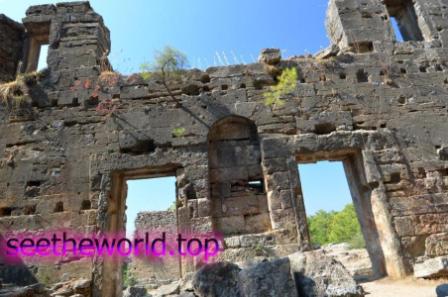
At a distance of 11 kilometers from Managwat are the ruins of an ancient city, found by archaeologists only in the 20th century. The history of the appearance of Seleucia goes back to the 2nd century BC, when the city was a fortress-type defensive structure. Later, people from the villages began to move to the city, and it quickly gained dominance on the coast.
Today, the ruins of Seleucia are overgrown with forest, but this does not prevent you from enjoying a walk and inspecting the district gates, statues of Roman deities and parts of the amphitheater that remained after years of destruction. In addition, for tourists, the authorities of Manavgat have completely restored the building of the baths, the temple, the agora and the necropolis. In these buildings, traces of history dating back several thousand years have been preserved, which is of considerable value in the cultural sphere of the country.
Green Canyon in Manavgat

In the vicinity of the city there are many natural objects that attract attention with their original picturesqueness. The canyon rightfully occupies the first place and has a number of features that distinguish it from other natural beauties of Turkey.
- Unique location (altitude 350 meters).
- Diversity of flora and fauna.
- High environmental performance.
You can get to the canyon as part of a tourist group. A special program has been developed for visitors, which includes climbing a serpentine, a yacht ride, getting to know the fauna of the canyon, as well as swimming in clear water. At the exit, you can buy souvenirs: postcards, magnets, key chains, handkerchiefs with the symbols of the canyon.
Amphitheater of Manavgata

The monument is located in the ancient city of Seleucia and is recognized as the largest Greek architectural structure in Turkey, belonging to the period of antiquity. It was here that mass events were held, and representatives of the Greek elite gathered to decide the future fate of the convicts.
According to scientists, the theater could accommodate more than 18,000 spectators and was equipped with an amazing acoustic system. Sound waves were transmitted for several kilometers, which made it possible to quickly gather people for gladiatorial fights and holidays. Also, the lower tier of the theater could be filled with water, if it was necessary in accordance with the script of the play.
Now the former grandeur of the building is evidenced by rows of spectators, massive columns at the entrance and a round stage.
During the excursion, you will learn about the specifics of the Greek theater and its productions, walk through the ruins, take photos against the sea background and feel the atmosphere of the ancient city.
Lake Titreengel in Manavgat
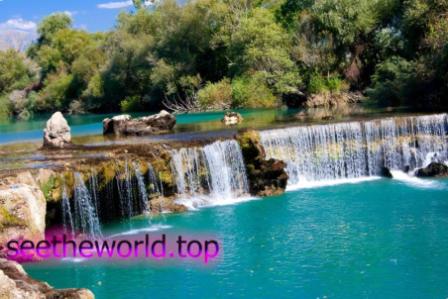
Despite its small size, this lake is known far beyond Manavgat. The reason for this was the name of the water area, which is translated from Turkish as “the restless lake”. The history of Titreengel is shrouded in legends.
One of them tells that in ancient times there lived an old man on the shore of the lake. He loved birds very much and gave them peace from the hunters who fished on the lake. One day the old man saw hunters shooting ducks. He covered the birds with his body and was killed by a bullet. After this event, the lake began to “tremble” in memory of the poor old man and his feat.
You can ride a boat on the lake, moor to the shore and taste delicious Turkish cuisine in a cozy restaurant. Hotels, recreation areas and fish markets are located along the coastline.
Oimapinar Dam in Manavgat

In 1983, a large dam was built in the highlands of the Manavgat River, the purpose of which was to generate electricity. Later, the dam became a local attraction and tourists from all over Turkey came to see it.
The construction of Oimapinar includes a powerful concrete arch and four turbines with a capacity of 130 MW. More than 40 percent of the total amount of energy produced is consumed by the plant that produces aluminum. To the left of the dam there are two spillways built according to ancient technology. However, today they perform the function of decorative structures, as they were closed in 1990 due to unnecessary use.
Visitors to the dam can see its work “from the inside”, learn about the peculiarities of Oimapinar’s work and take interesting photos.
Manavgata contact zoo

Those who go to Manavgat with children are recommended to go to the private zoo , built in the center of the city. The territory of the zoo is divided into thematic zones, where animals of various species live. Monkeys, peacocks and wild horses are the favorite inhabitants of the zoo. For the little ones, employees arrange performances with the participation of animals.
After a walk around the zoo, you can sit in a cafe and taste traditional Turkish dishes, as well as ride a miniature steam locomotive in all zones. Additional services include taking pictures with the animals and the opportunity to personally talk with some of them.
Observing the inhabitants of the zoo, you will learn the peculiarities of their lives and see the behavior of animals in conditions close to natural ones.
Manavgata Green Mosque

At the entrance to the city is a mosque, which is forbidden to those who do not preach Islam. This closed type building has an interesting architectural concept and is famous among believers. In 1973, the mosque was reconstructed and its upper part was crowned with four domes framing the main dome. For the construction of the roof, tin plates were used, which create an amazing light effect, shimmering in the sun.
Arched windows, a calm color scheme, strict lines, conciseness, ornaments on the facade illustrating the text of the Koran – all this is the embodiment of the Islamic religious world in an architectural form. Inside, the mosque is not much different from others, as there are strict rules for all buildings of this type when creating the interior of the shrine.